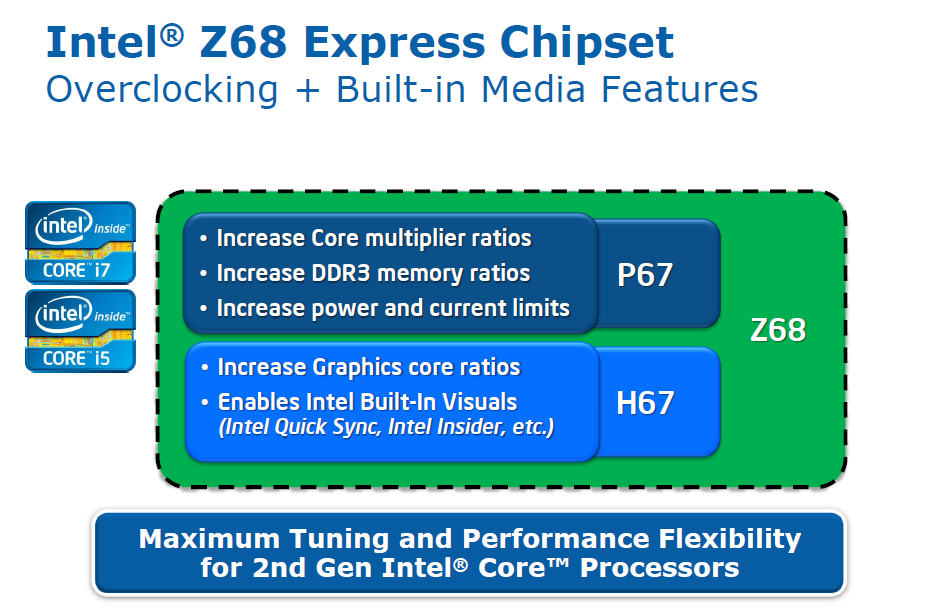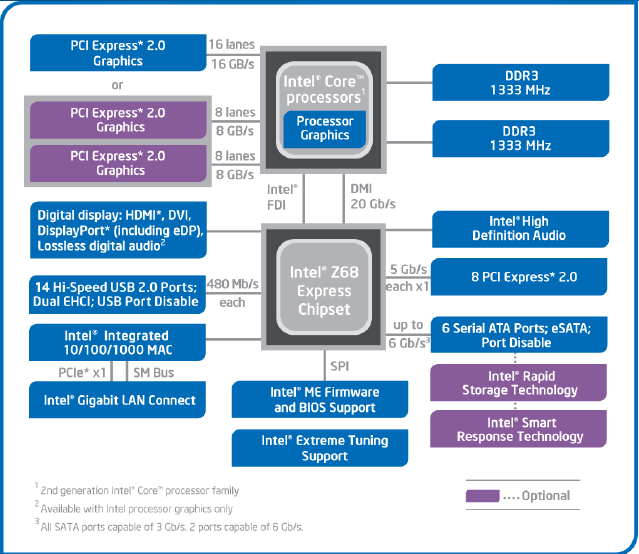The Intel Z68 Express Review: A Real Enthusiast Chipset
Z68 Express Chipset: What P67 Should Have Been
Editor's Note: If you've been holding off on a Sandy Bridge-based upgrade, anticipating Intel's Z68 Express, we have a special opportunity for you. CyberPower offered us one of its new Power Mega 1000 configurations with a Core i5-2500K and Asus Z68 platform to give away to a lucky Tom's Hardware reader. Flip through our review and, on the last page, enter to win a brand new PC, compliments of CyberPower!
We've Been Waiting...
Intel pulled off a big coup in January of 2011. It really wasn't a surprise that the company's Sandy Bridge architecture delivered impressive performance on the processing side. Rather, Intel's big win was the hardware-accelerated encode and decode functionality rolled up into its Quick Sync engine. Dedicating valuable die space to speeding up such a specific workload was a gutsy move. However, the performance we saw from Quick Sync in Intel’s Second-Gen Core CPUs: The Sandy Bridge Review was super-impressive. From there, we went even deeper, exploring the quality of what comes out the other end of Intel's video engine in Video Transcoding Examined: AMD, Intel, And Nvidia In-Depth. For the first time, Intel was able to school AMD and Nvidia in a field that both competitors historically dominated.
At least on the surface, Intel seemed to have the perfect enthusiast-oriented value-add to go along with its Cougar Point-based chipsets, P67 and H67 Express. Somewhere along the way, though, marketing got in the way and dictated that P67 would enable processor-based overclocking and dual-GPU configurations, while H67 could facilitate access to the integrated HD Graphics core, including Quick Sync. Thus, enthusiasts were explicitly blocked from utilizing the capability. And anyone who wanted to exploit the goodness of Quick Sync had to also lean on Intel's mediocre 3D engine as well.
Talk about a bum deal.
The silver lining was that, back in January, we knew about this chipset called Z68 Express that'd effectively combine the benefits of P67 with the integrated graphics handling of H67. That sounded promising. At least there was a planned platform that'd address the primary (and very unnecessary) limitations of both existing Sandy Bridge-compatible chipsets.
Now, the fact that Z68 paves the way for processor-based overclocking and integrated graphics is great. But no self-respecting gamer is going to overclock his K-series processor to 5 GHz and then lean on Intel's HD Graphics solution just for easy access to Quick Sync-accelerated transcoding. So, Z68 itself wasn't going to solve the company's little capability conundrum.
Get Tom's Hardware's best news and in-depth reviews, straight to your inbox.
But what we didn't know at the time was that Lucidlogix planned to unveil a piece of software called Virtu for H67- and Z68-based motherboards. Originally, Virtu was to let power users connect a display to the HD Graphics engine, along with a discrete card, and essentially run games on the add-in GPU, while transcoding apps would be accelerated natively via Quick Sync. We explored that implementation in Can Lucidlogix Right Sandy Bridge’s Wrongs? Virtu, Previewed.
Shortly after, though, Lucidlogix let us know that it'd found a way to operate the discrete card natively, virtualizing Quick Sync instead. That was the configuration we really wanted. And we got to take it for a test drive in Intel Z68 Express Chipset Preview: SSD Caching And Quick Sync.
But our early Z68 workhorse wasn't licensed, making it impossible to use all of Virtu's features. We were also running an early version of Intel's Rapid Storage Technology software, so we couldn't generate final performance numbers using the company's SSD caching feature. Today, the rev-limiter is off; we're able to kick the tires and light the fires on Z68 Express, the chipset we've been recommending you wait for since Sandy Bridge first launched earlier this year. We have more exhaustive Virtu testing, and more definitive SSD-based caching results.
Current page: Z68 Express Chipset: What P67 Should Have Been
Next Page Z68 Express: CPU Overclocking-
LuckyDucky7 The Intel 311 might be one of the weirdest products I've seen for a while.Reply
It doesn't have an impact on games and apps which are too large to be cached and 60 GB drives that blow the 311 out of the water can be had for 20 bucks more.
And as far as getting QuickSync, it's about time. Should have been done in P67 (along with USB 3.0 support and 6 x SATA III ports) is all I can say. -
acku In an ideal world, that's what we should have seen, but Lucidlogix's Virtu really makes Z68 worth it.Reply -
ghnader hsmithot Sir and madam working at intel.You make us customers look retarded.Thank you.Reply -
Olle P mayankleoboy1is this realy the platform for enthusiasts? with almost daily news of lga2011 ... its a little bit hard to get too happy with thisYes it is!Reply
I am going to buy myself a Z68 mobo and a Core i5-2500K within a few weeks.
If you buy yourself an LGA2011 based platform we can get together a month from now and compare the results!
... or rather not, since it will take at least half a year for the 2011 to become available.
Let's face it. For at least a full month from now the Z68 will be the enthusiast platform.
Then AMD's competition will arrive, and we'll see how much of an option that is. -
acku hmp_gooseWhat is this "QuickSync"? My people do not have this word …Reply
http://www.tomshardware.com/reviews/sandy-bridge-core-i7-2600k-core-i5-2500k,2833-4.html -
ta152h A good comparison would have been striping hard disks to compare against caching with EEPROMs. You'd have more capacity, a lot more, and wouldn't have a technology that dies after a certain amount of writes, which is dubious to use for something that's being used as a cache, and written on rather consistently.Reply
Performance of Raid 0 would be higher than a single disk, and you'd be increasing performance without a loss in capacity (per dollar). Or, if you wanted the same capacity. you could get higher performance disks, and compare them that way.
If I want to spend an extra $100 to make my computer faster, will it? Duh, of course. That's all this article is saying. Is it the best way to spend that $100? Well, that much isn't clear at all. It wasn't compared with much of anything else. Two high capacity disks striped, and two higher performance disks (but lower capacity) striped, versus one disk and EEPROMs. All should be the same cost. It's more useful information. You'd have three fundamental choices - huge capacity, high "Winchester" performance, and low capacity with EEPROM caching. You could do a search on the capacity trade-offs pretty easily, but the performance difference between this caching and a high performance magnetic disk in RAID 0 is much less clear. Obviously, the hard disks would win a lot of tests, and could be a better buy for a lot of people.
It is worth looking at. -
Olle P Another little detail:Reply
Larsen Creek was the work name for Intel's SSD.
The final name now in use is Larson Creek, as can be easily read in the picture. -
flong Hey, did I read this right, the theoretical maximum of the 2600K and 2500k chips is 5.7 ghtz???? Has anyone ever got a cpu that high? The most Ive read about is 5.0 ghtz and that was with water cooling. So does 5.7 ghtz exist?Reply -
My GoD!Reply
Intels output is capped at 1920x1200? Below my native res! I've been forced to put my buy on hold...
What were they thinking?

